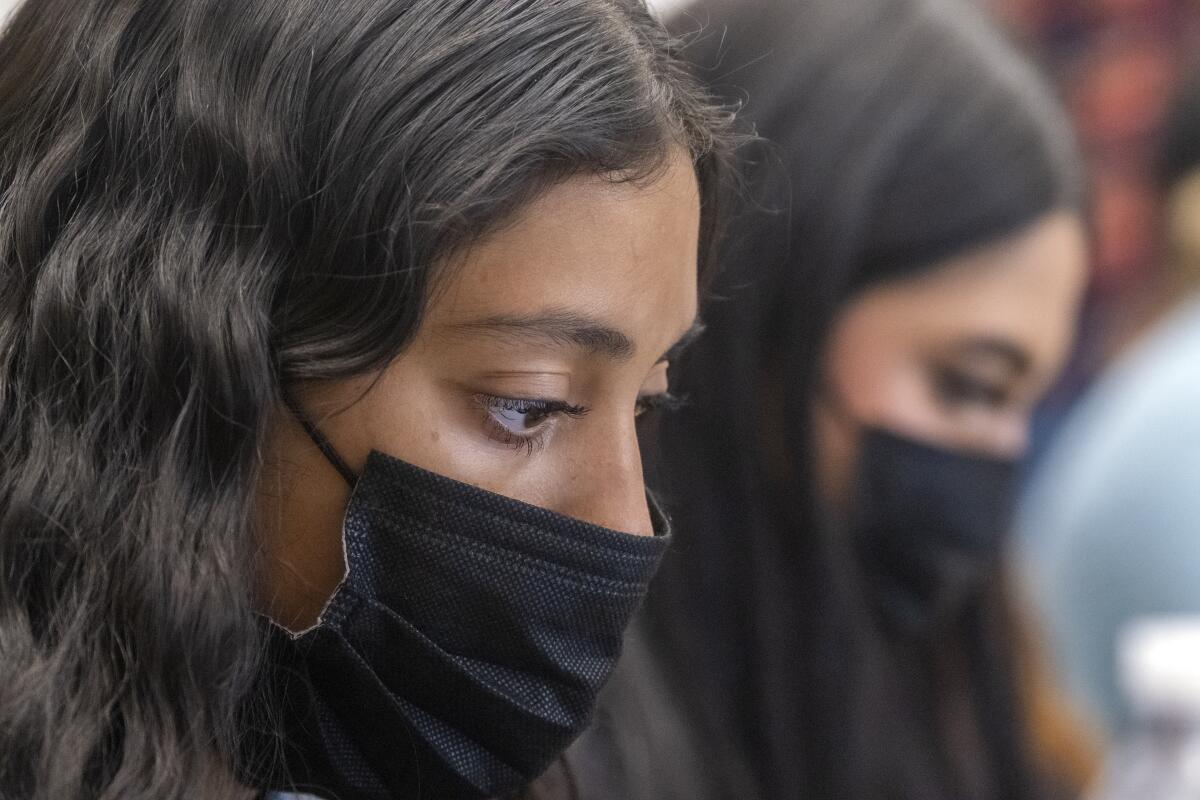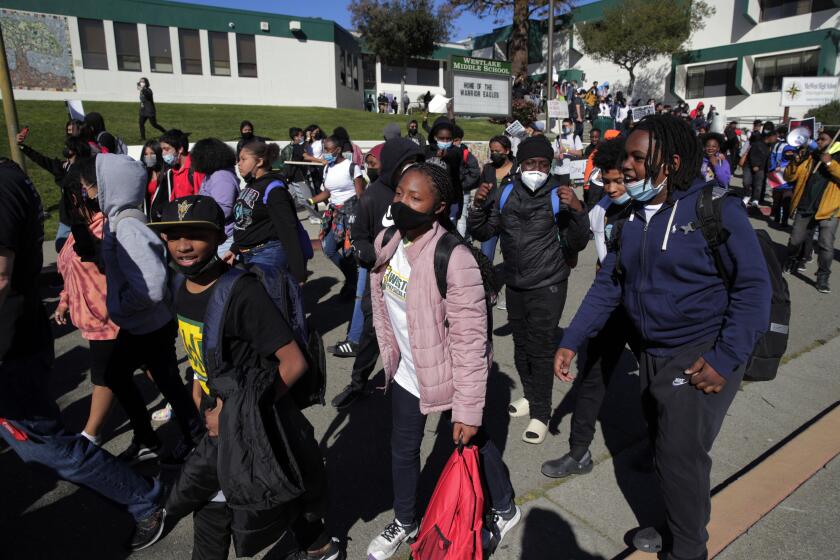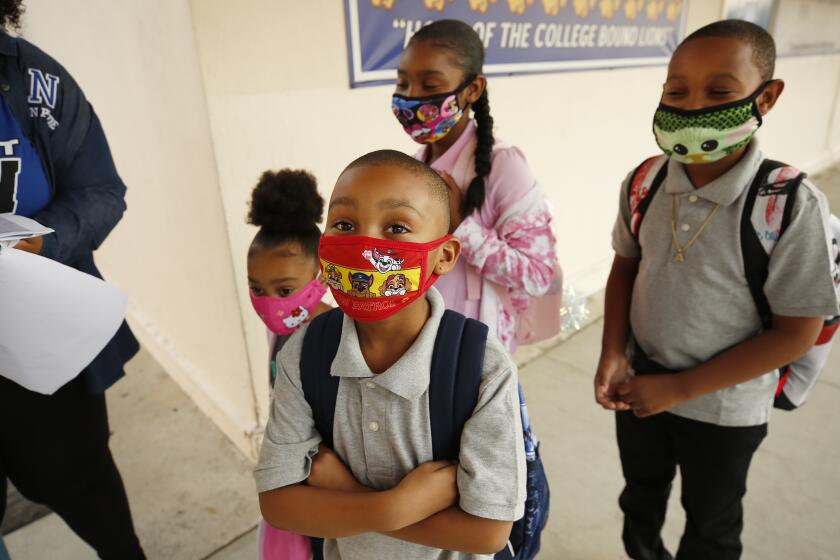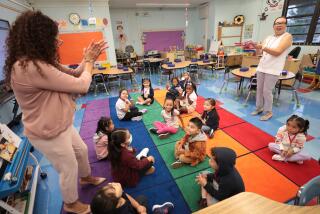Editorial: Declining enrollment shouldn’t always mean shutting down schools

- Share via
Where have all the children gone? California’s public school enrollment is down by 110,000 students this year, continuing a five-year decline, and no one is sure why or what to do about it.
Possible contributing factors include families moving out of state, students switching to private schools or homeschooling; a decrease in immigration to the U.S. and a lower birth rate. Saddest of all, there might be kids who gave up on their education after the COVID-19 pandemic school closures.
If the decline in public-school population fell evenly on schools throughout the state, it wouldn’t necessarily be a problem. As long as the budget is robust, there’s no reason the governor and Legislature can’t increase the amount the state allots for each student enrolled.
But the drop in enrollment has fallen on schools with disproportionately high numbers of Black students. Enrollment at some of these schools has fallen so low that they can’t offer as many courses and, in some cases, classes lack enough students to cover the teacher’s salary. When the numbers fall low enough, it can be hard to justify the expense of having a principal, school secretary, nurse and librarian.
California school districts may have to close some campuses as enrollments continue to decline. But they don’t have to take Oakland’s approach.
This is playing out right now in Inglewood, where the number of students has fallen from about 17,000 a couple of decades ago to fewer than 8,000 and the district is planning to close down an elementary school built for 400 students that has fewer than 150 this year. Parents are protesting the plan, saying that shutting down the school in a mostly middle-class Black neighborhood will do serious harm to the surrounding community.
Protests roiled Oakland earlier this year after the school district decided to close several schools with low enrollment. School districts across the state, especially large urban ones such as Los Angeles Unified, will soon face similar dilemmas.
The simplest solution to plunging enrollment may be to shutter schools where enrollment is too low. But that’s not necessarily the smartest approach. In many California neighborhoods the local school acts as a community center, opening its doors to residents for meetings, voting and health or other services.
A new study finds that when a school closes in a low-income Black neighborhood the area gentrifies, with more affluent people moving in. It’s an apparent study in racism: Even an excellent, predominantly Black school is seen by outsiders as a deterrent to moving into a neighborhood, not an asset. When a neighborhood school closes, Black families end up losing more than the neighborhood focal point.
In other words, declining enrollment isn’t just a school problem; it can destabilize neighborhoods.
The Legislature is considering a temporary change in funding formula that would soften the blow of declining enrollment, but it’s not a long-term solution.
This is a complicated problem that calls for a comprehensive approach from local and state officials to reimagine old ways of funding and operating public schools. The expansion of transitional kindergarten and preschool is a good start that will eventually help fill seats in elementary schools.
The school district is dropping toward 400,000 students. There aren’t enough teachers, counselors or nurses for hire. It’s time to envision a smaller school district.
Districts could also consider using staff differently rather than moving students around when enrollment falls. For example, why couldn’t a principal and secretary be assigned to cover two schools with drastically reduced populations?
This would require training and empowering teachers to run some aspects of their schools on days when the principal isn’t there. This shift in responsibility could actually lead to some interesting experimentation and smart administrative thinking.
It also might be possible for schools to offer community college classes, which would fill some classes and make it easier for people in the neighborhood to get a higher education.
Meanwhile, the state, in coordination with affected school districts, must work to understand better why so many students are disappearing and when it makes sense to try to stem the flow. Would bolstering academic and extracurricular offerings bring students back? What is happening at schools where enrollment isn’t declining and is it possible to replicate that?
It’s unlikely that all school closings can be avoided. There’s a point at which there are too few students to justify keeping a campus open. In those cases, the state could provide grants to turn those campuses into community centers with social services and recreational offerings. Free busing has to be offered to all displaced students.
But so far, the state isn’t moving swiftly or decisively enough to prevent that scenario. Temporary fixes won’t turn schools around. The state needs to get ahead of this problem, not struggle to keep up.
More to Read
A cure for the common opinion
Get thought-provoking perspectives with our weekly newsletter.
You may occasionally receive promotional content from the Los Angeles Times.












